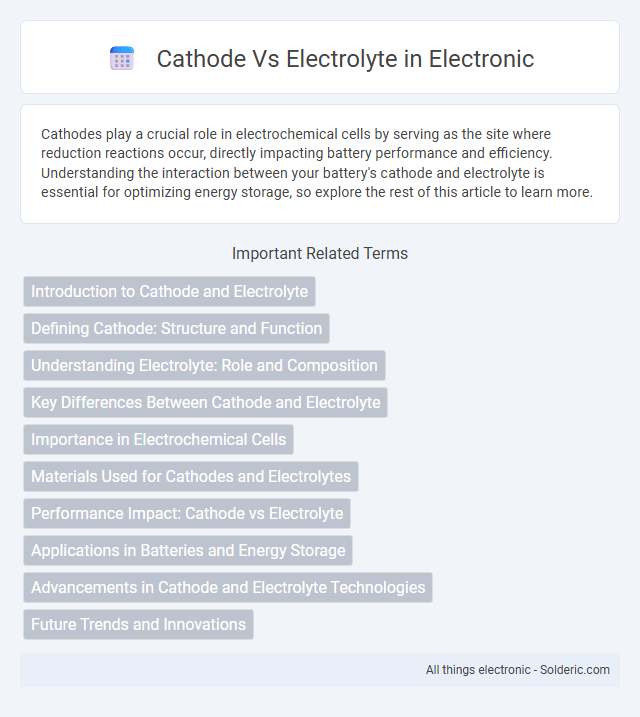Cathodes play a crucial role in electrochemical cells by serving as the site where reduction reactions occur, directly impacting battery performance and efficiency. Understanding the interaction between your battery's cathode and electrolyte is essential for optimizing energy storage, so explore the rest of this article to learn more.
Comparison Table
| Aspect | Cathode | Electrolyte |
|---|---|---|
| Definition | Electrode where reduction occurs in an electrochemical cell. | Medium that allows ion flow between electrodes in a cell. |
| Function | Accepts electrons and facilitates reduction reactions. | Conducts ions to complete the electrical circuit. |
| Location | At the positive or negative terminal depending on cell type (galvanic or electrolytic). | Between the cathode and anode, filling the cell. |
| Composition | Usually a solid material (metal or metal oxide). | Liquid, gel, or solid ionic conductor. |
| Role in Energy Storage | Stores and releases electrons during charge/discharge in batteries. | Maintains ionic conductivity for charge transfer. |
| Examples | Lithium cobalt oxide in Li-ion batteries. | Lithium salt dissolved in organic solvents or polymer electrolytes. |
Introduction to Cathode and Electrolyte
The cathode is the positive electrode in a battery where reduction reactions occur during discharge, playing a crucial role in energy storage and release. The electrolyte is a medium that allows ions to move between the cathode and anode, enabling the flow of electric current within the cell. Understanding your battery's cathode and electrolyte composition helps optimize performance and longevity.
Defining Cathode: Structure and Function
The cathode in a battery serves as the positive electrode where the reduction reaction occurs, typically composed of transition metal oxides or sulfides that facilitate electron acceptance during discharge. Its structure is engineered to maximize ionic conductivity and electron flow, often integrating layered or spinel crystal frameworks to enhance electrochemical performance. This design enables efficient lithium-ion intercalation and deintercalation, critical for maintaining battery capacity and overall energy density.
Understanding Electrolyte: Role and Composition
Electrolytes are essential substances composed of ions that facilitate the flow of electric charge in batteries, enabling efficient energy transfer. Their role involves conducting ions between the cathode and anode, maintaining ionic balance during charge and discharge cycles. Understanding electrolyte composition, including solvents and dissolved salts, helps optimize battery performance and longevity.
Key Differences Between Cathode and Electrolyte
The cathode functions as the positive electrode where reduction reactions occur, facilitating electron acceptance during battery discharge. The electrolyte is the ionic conductor medium that enables ion transfer between the cathode and anode, maintaining electrical neutrality within the cell. While the cathode undergoes chemical changes during operation, the electrolyte remains chemically stable, influencing battery efficiency and lifespan.
Importance in Electrochemical Cells
The cathode plays a crucial role in electrochemical cells by serving as the site where reduction reactions occur, enabling the flow of electrons through the external circuit. The electrolyte facilitates ionic conductivity, allowing ions to move between the cathode and anode, which maintains electrical neutrality and sustains the cell's electrochemical reactions. Efficient interaction between the cathode and electrolyte directly impacts the cell's voltage, capacity, and overall performance.
Materials Used for Cathodes and Electrolytes
Cathodes in batteries commonly utilize materials such as lithium cobalt oxide (LiCoO2), lithium iron phosphate (LiFePO4), and nickel manganese cobalt (NMC) oxide, chosen for their high energy density and stability. Electrolytes, essential for ion transport, are typically made from liquid organic solvents containing lithium salts, solid polymers, or ceramic compounds like lithium phosphorus oxynitride (LiPON). Understanding the distinct material properties of cathodes and electrolytes can help you optimize battery performance and safety.
Performance Impact: Cathode vs Electrolyte
The cathode significantly influences battery performance by determining energy density, voltage, and cycle life due to its active material composition, such as lithium cobalt oxide or nickel manganese cobalt. The electrolyte affects ionic conductivity, thermal stability, and safety, playing a crucial role in charge transfer efficiency and preventing dendrite formation. Optimal battery performance requires a synergistic balance between cathode chemistry and electrolyte composition to enhance capacity retention and minimize degradation.
Applications in Batteries and Energy Storage
Cathodes serve as the positive electrode in batteries, where they facilitate the reduction reaction by accepting electrons during discharge, crucial in lithium-ion and solid-state battery applications for energy storage. Electrolytes act as the ionic conductor between the cathode and anode, enabling ion transport that maintains charge balance and plays a vital role in the battery's overall efficiency, safety, and longevity. Advances in cathode materials like lithium cobalt oxide and solid electrolytes such as lithium phosphorus oxynitride enhance energy density, cycle life, and thermal stability, driving innovations in portable electronics, electric vehicles, and grid storage solutions.
Advancements in Cathode and Electrolyte Technologies
Recent advancements in cathode technologies include the development of high-nickel layered oxides and lithium-rich cathodes, which offer increased energy density and longer cycle life. Electrolyte innovations focus on solid-state electrolytes and ionic liquid formulations that improve safety and thermal stability while enhancing ionic conductivity. These improvements collectively contribute to higher-performance batteries with greater longevity and safer operation in electric vehicles and portable electronics.
Future Trends and Innovations
Future trends in cathode and electrolyte materials emphasize enhancing energy density, safety, and longevity of batteries through advanced nanostructured cathodes and solid-state electrolytes. Innovations in cathode chemistry, such as lithium-rich and high-nickel compositions, improve capacity and cycle stability, while solid electrolytes eliminate flammability risks and enable higher voltage operation. Your choice of battery technology will benefit from these emerging materials as they drive performance breakthroughs in electric vehicles and grid storage solutions.
Cathode vs Electrolyte Infographic

 solderic.com
solderic.com